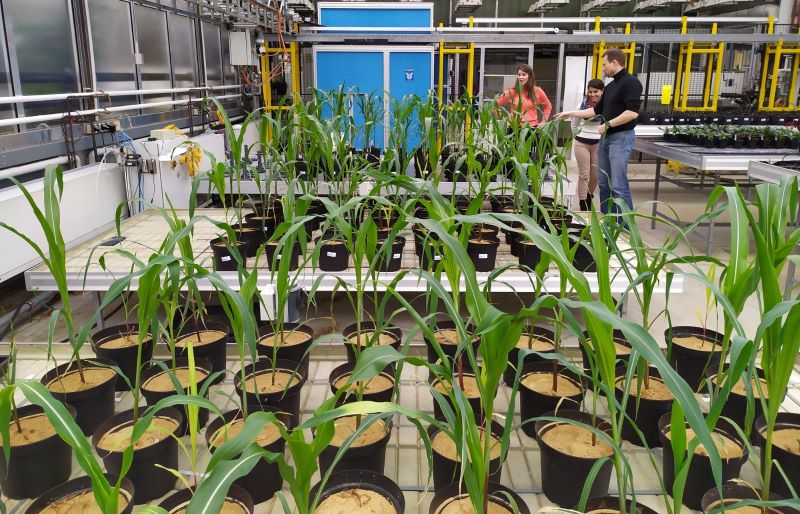


In an experiment conducted by EMBRAPA (Brazilian Agricultural Research Corporation), corn fertilized with the novel compound and treated with a natural phosphorus source produced 60% more dry matter than corn grown without fertilizer. In corn treated with a commercial phosphate, dry matter increased 30% (photo: Cauê Ribeiro/EMBRAPA Instrumentation)
Published on 07/22/2024
By André Julião | Agência FAPESP – Phosphorus is one of the essential nutrients required by crops, but as much as 80% of the substance applied in the form of fertilizer can be lost to chemical interaction with the soil.
A group of Brazilian researchers has developed a compound that fixes up to 35% of applied phosphorus in the soil, while also supplying nitrogen, another primary nutrient.
An article on the solution is published in the journal Communications in Soil Science and Plant Analysis. The study was conducted by researchers at EMBRAPA Instrumentation (a decentralized unit of the Brazilian Agricultural Research Organization), the Federal University of São Carlos (UFSCar) and the Santa Catarina Agricultural Research and Rural Extension Corporation (EPAGRI).
“When phosphorus is applied, it reacts with the other minerals in the soil to form insoluble phases, which can’t be absorbed by plants. We altered the structure of a fertilizer to protect the phosphorus it contains and optimize its effect,” said Amanda Giroto, who conducted the study as part of her PhD research at EMBRAPA Instrumentation in São Carlos with a scholarship from FAPESP.
The co-authors also include Gelton Guimarães, who received a postdoctoral scholarship from FAPESP.
The formula consisted of 50% urea, which releases nitrogen, and 50% powdered hydroxyapatite, a natural source of phosphorus. The compound, called UHap, was converted into granules by extrusion, a common process in the fertilizer industry.
“We needed the fertilizer to look the same as the products farmers and agronomists are used to and know how to apply, while also showing its advantages compared with these best-selling products,” said Cauê Ribeiro, a researcher at EMBRAPA Instrumentation and last author of the article.
Another advantage of the novel compound is the built-in nitrogen release, reducing the number of fertilizer applications required. Considering that a large crop acreage requires tons of fertilizer, reducing the number of applications saves money for the farmer.
“Part of the phosphorus stays in the soil and can be used in future so the saving is actually greater,” said Giroto, who received another postdoctoral scholarship from FAPESP to continue the research.
Experiments with corn
To compare the efficiency of the material with other sources of phosphorus, the researchers measured the availability of phosphorus in soils that received one of three treatments: the novel compound, hydroxyapatite only, and a commercial phosphate product known by the acronym MAP. All three were also applied to experimental corn crops in the laboratory.
Soils treated with the commercial fertilizer and hydroxyapatite contained 89% phosphorus on the first day of the experiment. After 21 days and 42 days, the availability of the nutrient fell to 28% and 18% respectively. Soil given the nanomaterial began the experiment with 53%, falling thereafter to 42% and 35% in the same timeframe.
Corn fertilized with the novel compound and treated with hydroxyapatite produced 60% more dry matter than corn given the control treatment, which did not involve any fertilizer at all. The crop that received the commercial fertilizer produced 30% more.
All three treatments had similar results in terms of absorption of phosphorus by the plants. However, the amount left in the soil and available for absorption by the plants was highest after treatment with the novel compound, pointing to efficiency in agricultural use.
In previous studies also supported by FAPESP, the researchers analyzed other aspects of the same material, such as the role of urea in increasing the solubility of hydroxyapatite and of another version of the nanomaterial when thermoplastic starch was added to the formula.
They also tested nanomaterials that released sulfur, another nutrient, for crops to use.
These studies were conducted during Giroto’s postdoctoral fellowship at Jülich Research Center in Germany.
“Fertilizers are strategic for Brazil, which currently depends entirely on imports. We need to reindustrialize this sector, and we must also develop more efficient products,” Ribeiro said (read more at: revistapesquisa.fapesp.br/en/strategies-aim-to-reduce-external-dependence-on-fertilizer-feedstock/).
The researchers are now looking for partner companies interested in mass-producing the material for use in large-scale experiments.
The article “Effect of urea: hydroxyapatite composites for controlled-release fertilization to reduce P complexation in soils” is at: www.tandfonline.com/doi/full/10.1080/00103624.2023.2268645.
Source: https://agencia.fapesp.br/52266